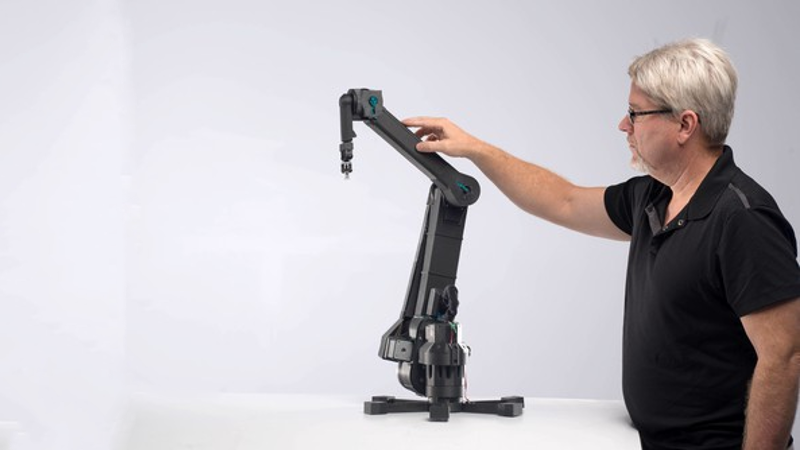Robotic arms – they’re useful, a key part of our modern manufacturing economy, and can also be charming under the right circumstances. But above all, they are prized for being able to undertake complex tasks repeatedly and in a highly precise manner. Delivering on all counts is DEXTER, an open-source 5-axis robotic arm with incredible precision.
DEXTER is built out of 3D printed parts, combined with off-the-shelf carbon fiber sections to add strength. Control is through five NEMA 17 stepper motors which are connected to harmonic drives to step the output down at a ratio of 52:1. Each motor is fitted with an optical encoder which provides feedback to control the end effector position.
Unlike many simpler projects, DEXTER doesn’t play in the paddling pool with 8-bit micros or even an ARM chip – an FPGA lends the brainpower to DEXTER’s operations. This gives DEXTER broad capabilities for configuration and expansion. Additionally, it allows plenty of horsepower for the development of features like training modes, where the robot is stepped manually through movements and they are recorded for performance later.
It’s a project that is both high performing and open-source, which is always nice to see. We look forward to seeing how this one develops further!




















Dexter, get me a beer.
Your forgot to say “sudo”.
No. Leave.
Troll or child?
Speaking for the unrepresented 20% of the population, there needs to be its mirror twin “SINISTER”.
B^)
Meanwhile, in Canadian, it’s spelled “DEXTRE”, and it’s kind of over the top:
http://www.asc-csa.gc.ca/eng/iss/dextre/data-sheet.asp
I like the 180+ page assembly manual but I can’t find the part number for the harmonic drive anywhere. Is it listed somewhere and how much do they cost?
I saw a short video on Youtube of this robot a year or so ago. Then they seem to have great plans for it.
But from the 180 page pdf I looked at http://hdrobotics.com and this robot arm is not on their site ???
20 minutes later, 2nd try and I found it:
http://hdrobotic.com/store/fully-assembled-dexter
Fully assembled dexter is USD4800. Kit is USD 3000
Those small harmonic drive gear boxes are only affordable on the second hand market.
Expect a price around EUR200 (2nd hand).
You can find them on Ali / Ebay / China and on robotdigg.com
Harmonic drives are pretty pricy. Depending on gearing and size, figure anywhere from $300-1500. They aren’t that typical in most robots due to their lower torque handling ability.
Almost looks like something one could build.
https://upload.wikimedia.org/wikipedia/commons/thumb/2/21/HarmonicDriveAni.gif/240px-HarmonicDriveAni.gif
Might be an alternative.
https://spectrum.ieee.org/automaton/robotics/robotics-hardware/sri-demonstrates-abacus-rotary-transmission
Oh, you mean this: https://hackaday.com/2016/12/02/abacus-drive-is-a-speed-to-torque-game-changer/
(Such a Hackaday shill I am! Unashamed, frankly.)
Harmonic drives do not lend themselves very well for hobby level 3D printing due to the materials needed to get required stifness, the need for a flexible deformable part and tolerances of small ribs.
There have been some attempts in the DIY market from turning a timing belt inside out, but nothing beyond toy level. With a bit of searching you can buy “uncut” timing belts with a large width and this may be a good part for a harmonic drive, but I haven’t seen such an attempt yet.
On the other hand. Cycloidal drives have similar gear ratio and stiffness and these lend themselves much better for hobby level 3D printing. This is one of the best attempts I’ve seen:
https://www.youtube.com/watch?v=U9Mq-FqiDDY
I especially like the combination of a cycloidal drive with a (half) planetary gear:
SunWheel -> Planetwheels -> Excenter -> Cycloidal disks -> Outer Ring.
Harmonic drives are used in a lot of robots, I would actually say that may be one of their primary uses. Both SCARA and arms use them in their joints.
“Harmonic drive” is a trademark, according to Wikipedia. The common name is “strain wave” gear.
As for whether they can be 3D printed:
https://hackaday.com/2018/06/19/printing-strain-wave-gears/
https://hackaday.com/2017/03/02/unique-planetary-gearbox-can-be-custom-printed-for-steppers/
https://hackaday.com/2017/01/17/3d-printed-strain-wave-gear-needs-your-help/
Short answer “yes”. Longer answer: work in progress. Looks fun/important to play with.
Reading the assembly manual, putting together my Airwolf turbine heli was a breeze compared to the tedious steps required to cobble together all the components of this project. If it were sold in assembled form, I’d buy one – but some of us don’t have the time to fart around 3d printing parts and then trying to put it together, then not to even mention the software to make it work and do cool things.
Someone should do what the Elecraft community does (they have folks that will build the kit for you for a fee).
Do you have time to read the comment?
HD robotics sells the completely assembled Dexter for USD4800.
Exactly which harmonic drives are used
HanZhen Harmonic Drives type….??
Super nice arm though. Would be even more great if those strain wave gear drives from the contest could be used…
Seems like a nice project even if I can’t see exactly what it would be useful for. At that size wouldn’t a delta type robot be more practical for most use cases?
There are commercial arm type robots at this size range, FANUS and a couple other companies make them, of course they are much more solidly built.
50um repeatability, but how much does the robot flex with a load?
The structural components are carbon fiber, steel shafts, ball bearings, motor cases, etc… not the 3D printed parts; the plastic just holds the structure while the epoxy hardens during assembly. So the arm body doesn’t flex much at all. The joints will turn, but the encoders pick that up and the control system runs the motors to correct the error.
“So the arm body doesn’t flex much at all” I wold have to see that to believe it.